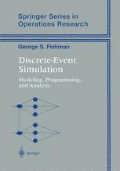Abstract
Chapter 8 reveals that every algorithm that generates a sequence of i.i.d. random samples from a probability distribution as output requires a sequence of i.i.d. random samples from u(0, 1) as input. To meet this need, every discrete-event simulation programming language provides a pseudorandom number generator that produces a sequence of nonnegative integers Z 1, Z 2,... with integer upper bound M > Z i ∀i and then uses U 1, U 2,..., where U i := Z i /M, as an approximation to an i.i.d. sequence from u(0, 1).
Access this chapter
Tax calculation will be finalised at checkout
Purchases are for personal use only
Preview
Unable to display preview. Download preview PDF.
References
Cassels, J.W.S. (1959). An Introduction to the Geometry of Numbers, Springer-Verlag, Berlin.
Fishman, G.S., and L. Moore (1986). An exhaustive analysis of multiplicative congruential random number generators with modulus 231 — 1, SIAM J. Sci. and Statist. Comput., 7, 24–45.
Fishman, G.S. (1990). Multplicative congruential random number generators with modulus 2P: an exhaustive analysis for ß = 32 and a partial analysis for ß = 48, Math. Comp., 54, 331–334.
Fishman, G.S. (1996). Monte Carlo: Concepts, Algorithms, and Applications, Springer-Verlag, New York.
Hörmann, W., and G. Derflinger (1993). A portable random number generator well suited for the rejection method, ACM Trans. Math. Software, 19, 489–495.
Jannson, B. (1966). Random Number Generators, Almquist and Wiksell, Stockholm.
L’Ecuyer, P., and S. Tezuka (1991). Structural properties for two classes of combined random number generators, Mathematics of Computation, 57, 735–746.
L’Ecuyer, P., and T.H. Andres (1997a). A random number generator based on the combination of four LCGs, version: November 25, 1997, University of Montreal, available at http://www.iro.umontreal.ca/—lecuyer.
L’Ecuyer, P., and T.H. Andres (1997b). A random number generator based on the combination of four LCGs, Mathematics and Computers in Simulation, 44, 99–107.
L’Ecuyer, P. (1999). Personal communication.
Overstreet, Jr., C.L. (1974). The relationship between the multiplicative and mixed generators modulo 2“, Computer Science Department, Virginia Polytechnic Institute and State University, Blacksburg.
Park, S.K., and K.W. Miller (1988). Random number generators: good ones are hard to find. Comm. ACM, 31, 1192–1201.
Payne, W.H., J.R. Rabung, and T.P. Bogyo (1969). Coding the Lehmer pseudorandom number generator, Comm. ACM, 12, 85–86.
Schrage, L. (1979). A more portable FORTRAN random number generator, ACM Trans. Math. Software, 5, 132–138.
Author information
Authors and Affiliations
Rights and permissions
Copyright information
© 2001 Springer Science+Business Media New York
About this chapter
Cite this chapter
Fishman, G.S. (2001). Pseudorandom Number Generation. In: Discrete-Event Simulation. Springer Series in Operations Research. Springer, New York, NY. https://doi.org/10.1007/978-1-4757-3552-9_9
Download citation
DOI: https://doi.org/10.1007/978-1-4757-3552-9_9
Publisher Name: Springer, New York, NY
Print ISBN: 978-1-4419-2892-4
Online ISBN: 978-1-4757-3552-9
eBook Packages: Springer Book Archive

